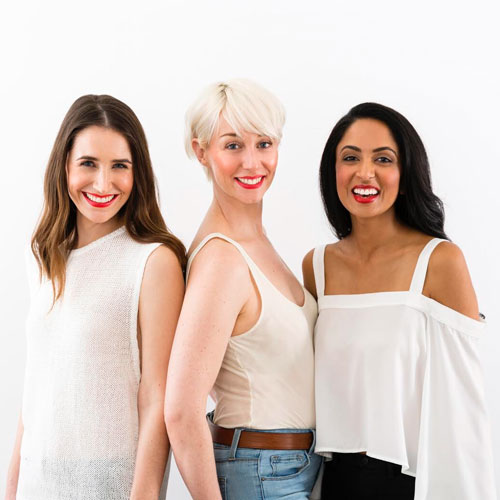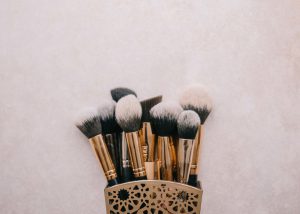Most recently updated 1/12/21
The term clean beauty may still be newish, but we’ve been (rightfully) scrutinizing the ingredients in beauty products for ages. Red lipstick was once made with mercury. Arsenic was a key active in acne treatments. The reason you won’t find these toxins in any formulas today is because people began raising questions. And really, that’s what clean beauty is all about — a deeper consideration for the safety of what we put on our bodies every day. Here’s what you really need to know.
Clean beauty isn’t the same as natural
In clean beauty, safety — not the source — is the priority. And that actually has very little to do with whether a product is natural or not. “Natural does not necessarily mean safe,” notes Marisa Plescia, NakedPoppy’s research scientist. “Poison ivy is natural, but I guarantee that no one wants to use poison ivy in their skincare.” (In fact, the mercury that used to be in lipstick? That’s natural.) On the flipside, just because something is synthetic, or manmade, doesn’t mean it is unsafe. “Sometimes synthetic chemicals are better options for safety, toxicity, and sensitization concerns,” adds Plescia. If you’d like to know the specific differences between all of these terms, check out our handy cheat sheet.
Clean beauty prioritizes your health
And yet: There are some synthetic chemicals still on the shelves that are decidedly not better. (Check them out on our no list.) Some are known or suspected carcinogens [1], i.e. cancerous. Some are endocrine disruptors [2], substances that mimic sex and thryoid hormones, throwing our bodies off balance and leading to a whole host of problems. A clean product doesn’t contain anything that is suspected (or proven) to put your health at risk.
Clean beauty is better for the environment
Beyond protecting your wellbeing, clean beauty formulas protect the wellbeing of the planet. In the same way that, say, endocrine disruptors can build up in your body and wreak havoc, certain chemicals can build up in the earth and pose a threat to the precious ecosystem.
When we wash our faces, that cleanser’s ingredients can go on to contaminate the water supply. That mascara you tossed in the trash? It’ll end up in a landfill, where its chemical components can seep into soil [3]. Clean formulas eschew ingredients that are harmful to or persist in the earth, so you can feel better about what you’re washing down the drain.
Clean beauty achieves what the government does not
If clean simply means that a product is safe, shouldn’t that just be a standard — not an exception? Yes, it should. But it isn’t. Unfortunately, the United States is way behind when it comes to monitoring and enforcing beauty product safety. For example: The European has banned or restricted the use of more than 1,300 ingredients, while the United States has banned or restricted 30 [4]. And the last significant cosmetic safety legislation happened in 1938, when the FDA passed the Federal Food, Drug, and Cosmetic Act.
According to this act, the FDA has no authority to recall a beauty product — the manufacturer essentially must volunteer. What’s more, cosmetic products don’t even need to be reviewed or approved by the FDA before they go to market. All of this to say, it’s up to you to choose products that are clean and safe.
How to shop for clean beauty
So here’s the catch. Just like beauty products aren’t very well regulated, neither are clean beauty products. Meaning there’s no agreed-upon definition of what makes a product clean that everybody just follows — there’s no seal or symbol you can rely on for a clean thumbs up. (Hence why cleanwashing is such a problem.) For this reason, it’s incredibly important that you pay attention to a brand’s individual standards when you’re shopping for clean products.
Many choose to follow the European Union model, which is a great start. At NakedPoppy, though, we err (a little further) on the side of caution: While the EU allows about 7,000 chemicals, we give just 950 the green light, based on the most up-to-date research. It’s strict, but it means you can feel confident about the level of clean of our products.
To make the shopping process even more painless, we’ll even do it for you (if you’d like). The NakedPoppy assessment uses an intelligent, highly specialized algorithm to curate clean makeup and skincare picks, customized for you. In 3 minutes, you’ll have the exact shade of foundation you need, the cleanser that best suits your skin type, and the treatment that’ll help you troubleshoot whatever issue you’re facing at the moment. Of course, all of it is as clean as it gets. So, you feel good about the products that help you look good. Ultimately, isn’t that what everyone deserves?
Get “shockingly accurate” clean beauty picks. Take your beauty assessment.
References
[1] Known or suspected carcinogens:
https://www.niehs.nih.gov/health/materials/formaldehyde_508.pdf
[2] Endocrine disruptors:
https://www.ncbi.nlm.nih.gov/pubmed/27286252
[3] When we wash our faces, that cleanser’s ingredients can go on to contaminate the water supply. That mascara you tossed in the trash? It’ll end up in a landfill, where its chemical components can seep into the soil:
[4] The United States has banned 30:
https://www.fda.gov/Cosmetics/ProductsIngredients/Ingredients/ucm128042.htm



Comments